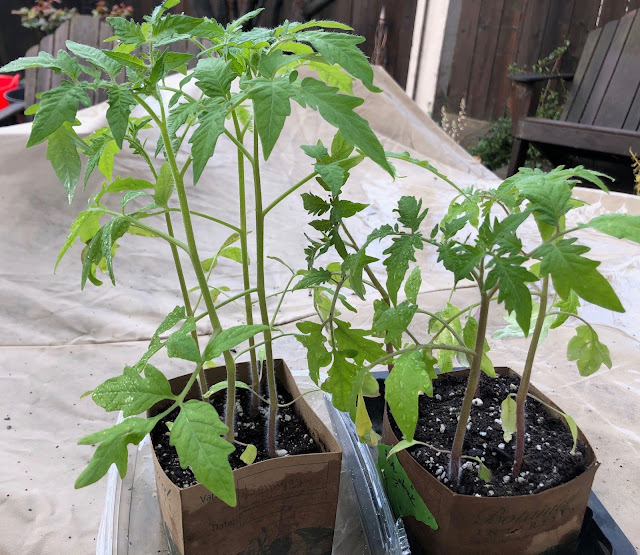
|
|
If your tomato seedlings look this leggy, transplant them into bigger pots. They'll grow strong roots before they go into the ground next month. (Photo: Kathy Morrison)
|
Wet weather gets spring off to cool, moist start
After a wet winter, March continues to be moist.
The first full week of our Sacramento spring has rain in the forecast almost every day, along with cooler-than-normal temperatures. That lack of warm, dry days will stretch out the bloom season for daffodils and other bulbs, but it also puts the brakes on summer-minded vegetables.
Don’t even think about transplanting tomatoes outside for at least another week or two. At best, they’ll just sit there, looking miserable; at worst, they could rot.
If seedlings are too big for their trays, transplant them into bigger pots, so they can develop strong roots. Then move them outside into the garden in late April, when weather should be more reliably warm and dry.
How wet has our weather year been so far? We’re officially out of drought danger for 2019. Since Oct. 1, Sacramento has received 18.73 inches, according to the National Weather Service. That’s 3.2 inches above average and 5 inches more than this time last year. Meanwhile, March is on target for its average of 2.75 inches, or a little extra. So keep the sprinklers off.
All that rain makes for moist, easy-to-work soil, which makes planting, fertilizing and weeding easier, too.
* Spring brings a flush of rapid growth, and that means your garden is really hungry. Feed shrubs and trees with a slow-release fertilizer. Mulch with a 1-inch layer of compost.
* Feed roses as they start to bud out. Bushes are growing rapidly and will start blooming in April.
* Apply slow-release fertilizer to lawns. Avoid weed-and-feed mixtures around lawn trees; they can kill the tree as well as any dandelions.
* Prune and fertilize spring-flowering shrubs and trees after they bloom. Try using well-composted manure, spread 1-inch-thick under the tree. This serves as both fertilizer and mulch, retaining moisture while cutting down on weeds.
* Cut back and fertilize perennial herbs such as oregano to encourage new growth.
* Weed, weed, weed! Pull out bindweed as it sprouts. Tackle buttercup oxalis and other fast-growing invaders before they go to seed.
* Shop for perennials. Many varieties are available in local nurseries and at plant events. They can be transplanted now while the weather remains relatively cool.
* Plant summer bulbs and tubers, including dahlias, gladiolus, tuberous begonias and callas.
* Transplant lettuce and cabbage seedlings; look for fast-maturing varieties.
* From seed, plant beans, beets, carrots, corn, radishes and squash. Plant onion sets.
* In the flower garden, plant seeds for asters, cosmos, celosia, marigolds, salvia, sunflowers and zinnias.
* Transplant petunias, zinnias, geraniums and other summer bloomers.

